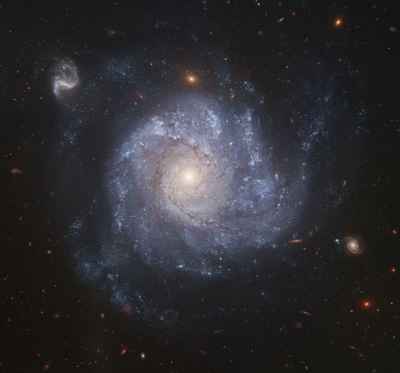The Hubble Space Telescope has provided stunning details about the galaxy facing us, cataloged as NGC 1309 captured in a color image
Avi Blizovsky

As you look at windmills in baby toys that spin with every light breeze, so did the dramatic spiral galaxy captured in one of the last images taken by the Hubble Space Telescope. Stunning details about the galaxy that shows its face to us, and is cataloged as NGC 1309 captured in a color image.
Recent observations of the galaxy taken with visible light and infrared cameras are combined into a spectacular color image of many of the galaxy's most beautiful formations. The light blue areas are stars in the formation stage dotted in the spiral arms, while the reddish sand follows the structure of the spirals and the yellowish center filled with a population of old stars. The picture is completed by many distant background galaxies.
However, this picture of the galaxy is much more than just a nice picture. It helps astronomers measure more precisely the expansion rate of the universe. NGC 1309 was home to the supernova SN 2002fk, whose light reached Earth in September 2002. This supernova event, known as an LA type, resulted from material captured by a Malvihu white dwarf in a binary star system.
When the white dwarf gathered enough mass and could no longer support its own weight, the star exploded and became the brightest star in this galaxy for several weeks.
LA-type supernovae such as SN 2002fk in NGC 1309 are used by astronomers to calibrate the distance scale in the universe. By comparing nearby LA supernovae to more distant ones they can estimate not only that the universe is expanding but also that this expansion is accelerating. However, this method only works in galaxies whose distance is known with great precision.
This is where the Hubble Space Telescope comes into play. Because NGC 1309 is a relatively close galaxy to them, the high resolution of Hubble's Advanced Camera can help determine the exact distance to the galaxy by observing the light of a particular type of variable star called a cupid variable. Such cupids have been well studied in our galaxy. And they regularly change their brightness at a rate proportional to their intrinsic brightness. By comparing their rate of change with the knowledge of their original brightness. In a similar way, the distance to the galaxy NGC 1309 and therefore also to the supernova of 2002 can be measured. The expansion of the universe was discovered by Edwin Hubble, after whom the telescope is named. Almost a hundred years ago, but only recently was it discovered that the rate of expansion is accelerating and therefore also to the cosmological models.
These images were taken in August and September 2005. The galaxy lies 100 million light-years from Earth (30 megapascals). It is one of about 200 galaxies that make up the Eridanus cluster of galaxies.
For the information of the Hubble Scientific Institute on the Universe Today website
